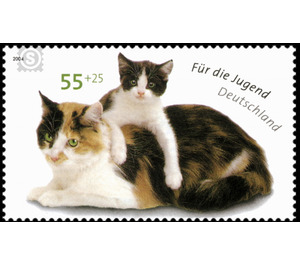For the youth: cats - Germany / Federal Republic of Germany 2004 - 55 Euro Cent
| Country | Germany / Federal Republic of Germany |
| Issue Date | 2004 |
| Face Value | 55.00 |
| Perforation | K 13 3/4 |
| Stamp Type | Postage stamp |
| Item Type | Stamp |
| Chronological Issue Number | 2277 |
| Chronological Chapter | GER-BRD |
| SID | 263600 |
| In 19 Wishlists | |
The special stamp series "For the Youth" appears with supplements in favor of the "Stiftung Deutsche Jugendmarke e.V.". This promotes with the contract proceeds measures for the benefit of youth in Germany. The current postage stamps show domestic cats in typical life situations. Next to the dog, the cat is one of the most popular pets. With it, the human often lives permanently together. In the hunt, even domestic cats show the behavior of their wild ancestors. Often cats are loners. Occasionally, however, they also form small social organizations. These consist mostly only of females and young animals. Twice a year, female catlets can give birth to a litter of four to six cubs. The mother alone takes care of the rearing of her children. In many cases, they maintain a close body contact. The mothers teach their offspring the most important survival techniques, such as behavior during hunting and at risk.


